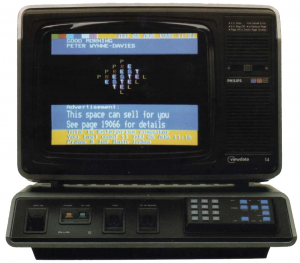Viewdata is a generic term which encompasses technologies such as Teletext and Videotext.. It is usually presented in a ‘user friendly’ display format of 25 lines each of 40 characters. By using up to eight colours, and block graphics, sophisticated pages can be built up to present all manner of interesting information.
Most people are familiar with the teletext pages available on analogue television in the UK until around 2010. What you may not know is that in the late 20th century, there was an interactive form of these available too. In the UK, British Telecom ran their service, Prestel, available for a local telephone call across most of the country, but there were numerous private and hobby systems also available using the same format, and several other services available around the world.
With a suitably enhanced television, set top box, terminal or home computer and modem, you could access news and information, send emails, interact with other users and groups of users, play games, download software, manage your bank account, check train times, do your shopping, indeed everything that we use the Internet for today. And this was launched in 1979!
Using viewdata services was simple. Since early terminals used simple numeric keypads based on the  telephone keypad, commands were simple. Generally, you keyed a single number to select an option, or pressing # would move on to the next frame on a page.
telephone keypad, commands were simple. Generally, you keyed a single number to select an option, or pressing # would move on to the next frame on a page.
Every page of information was numbered, and each page could have up to 26 parts, or “frames”, indicated by a suffix a-z. Pressing a * allowed you to request a specific page number, which you ended with #. e.g. Micronet 800 was named such as it was available by keying *800# on Prestel. This would take you to page 800a. Pressing # would then take you to 800b, and so on. As page numbers could be up to nine digits long, this gave a theoretical maximum of 26 billion frames of information!
A * also introduced a number of simple navigation commands. *00 refreshed the page in case it had been corrupted by a noisy telephone line. *09 refreshed but included any updates to the page since you first looked at it, and *# took you back to the page you were looking at previously.
Other services introduced alphabetic page names, and Prestel eventually added keyword aliases, allowing commands such as *MAILBOX#, however the basic interface remains the same.
For valuable information, on the commercial services, it was possible to charge users for pages viewed. Whilst most pages would be free, individual frames could be charged anywhere between 0.5p and 99p each. This explains the “0p” you will see in the top right corner of most examples of pages seen here. This is where the price was displayed – free pages were therefore, of course, zero pence. In the very early days, most pages had a price attached, even the indexes, so that you could run up a significant charge before you had even found the information you were looking for. This strategy was quickly dropped…